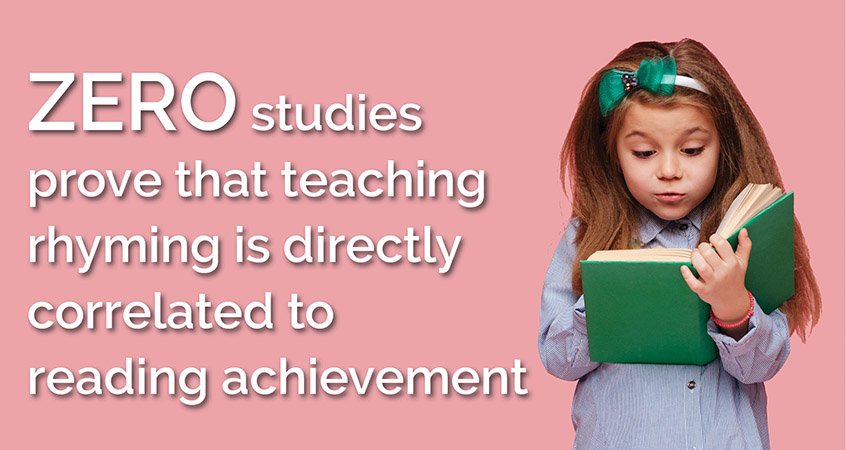How Much Time Should Be Spent on Teaching Rhyming?
As I delivered Pari to her Kindergarten classroom, her teacher pulled me aside to express her concerns. I was pleased with Pari’s progress – she knows all her sounds, is beginning to blend them together and is motivated to read. I also knew the problems – Pari has difficulty rhyming.
I understand the teacher’s perspective; rhyming is assessed early and often. Therefore, our Kindergarten classrooms put a heavy emphasis on rhyming. As a former first grade teacher, I spent very little time with rhyming activities. I just wanted students to understand the alphabetic principle and use that skill to decode words! Why this emphasis on rhyming in Kindergarten? Cheryl and I have dug into this issue.
Here’s what we found…
The Research
Timothy Shanahan, in his literacy blog Shanahan on Literacy, noted that rhyming can be predictive of later reading achievement, but it is not as accurate as other skills, such as letter-sound knowledge. He then states definitively,
“Given that there are no studies showing that teaching rhyming improves reading achievement (or even makes kids more amenable to and successful with phonemic awareness instruction), I wouldn’t want to spend much time teaching it.”
In 2002, Bonnie Macmillan conducted a critical review on rhyming and reading. She concluded,
“Both correlational and training-study evidence, involving beginning readers, suggests that the more letter-sound teaching children receive at this stage (undiluted by rhyme awareness instruction), the better their reading progress.”
Stuart Yeh and David Connell reinforced this conclusion in their 2008 research involving young Head Start children. They wrote,
“It appears that explicit instruction emphasizing phonemic awareness may be more likely to prevent reading difficulties, especially among disadvantaged children such as those served by Head Start, than instruction emphasizing rhyming, vocabulary development or incidental exposure to phonological activities in the context of story reading.”
Efficient, Effective Instruction
In our CR Success Learning early literacy programs, Jump Start and First Steps, we do not explicitly assess or teach rhyming skills. We teach at the phoneme level. Kindergarten teachers we train will ask about rhyming instruction. We simply explain the research and show our results. It has long been assumed that children’s phonological understanding progresses from large (rhyme) units to small (phoneme) units. Research, however, indicates that young children can perform phoneme tasks, which are directly correlated to reading achievement.
Onset-rime instruction is low-utility skill; teach at the phoneme level first.
Teaching larger phonetic units, such as onset-rime, is not based on how the English language is constructed. Bonnie Macmillan noted that rhyming and onset-rime instruction permeated early literacy instruction, partly due to Marilyn Jager Adams’ endorsement of such instruction. However, this teaching was based on a faulty assumption,
“In a simple CVC word there are, not two symbols (one for the onset and one for the rime), but three letter symbols each separated in space, each symbol representing, and illuminating, a phoneme unit. Onsets and rime units, however, are not differentiated or made explicit by our writing system in this way.”
It has been our experience that, as children advance in their awareness of phonemic awareness and letter-sound knowledge, they improve in their ability to rhyme, which Shanahan terms as a “somewhat separate skill.” This belief has been reinforced by studies, such as the one conducted by McNorgan, et al, 2014 and Nation and Hulme, 2010.
Pari’s Kindergarten experience so far has had her jump from task to task: alliteration, rhyming, memorizing sight words, learning letter names and sounds, concepts of print drills through memorization of unfamiliar words and syntax.
Research tells us that phonemic awareness and letter-sound instruction will move her faster and give her the foundation necessary for proficient reading.
Teach the key phonemic awareness skills of segmenting, blending, and manipulating phonemes with letter-sound knowledge.
Enjoy rhymes and playful use of language as you share classic nursery rhymes, fingerplays,
songs, and stories with children.After students have developed the alphabetic principle, teach word families with such activities as “If I can spell cat, I can spell bat, mat, pat, rat, that, sat, vat, fat, hat.”
Co-written by Cheryl Rose Campbell and Tricia Gray, part of the team of people supporting your educational learning needs.





